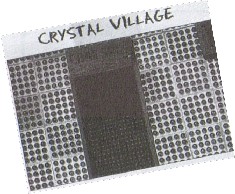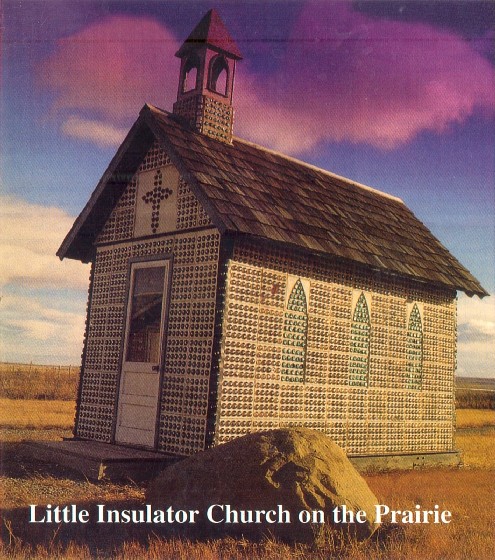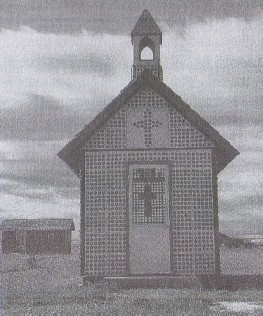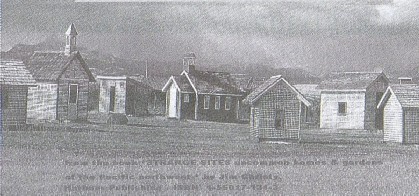Crystal Village
Reprinted from "Crown Jewels of the Wire", November 2002, page 3
A battered sign assured me! was at the Crystal Village. A thick chain dragged
on the ground between two posts and the sun glimmered on the sides of structures
that seemed to sprout among the weeds. There was no one about. Traffic roared by on Highway
3. The door of the church smacked methodically against its jamb like a lazy
horse swatting flies, and the wind made lonely music around the corners of a coal
shed. This was years ago, but I was already too late.

 The Cover: CRYSTAL VISIONS
In 1970, about the time Pincher Creek resident
Boss Zoeteman retired, the phone company was changing technologies and no longer
required the clusters of glass insulators that topped telephone poles. What to
do with the thousands of now-obsolete glass beakers? Boss's first idea was to
make his granddaughter a doll house. But, never one to think small, Boss then
made what would today be called a paradigm shift: "To heck with the doll
house," he thought. "I'm going to create a city!"
Crystal Village
is a collection of 13 structures, including a school, church and trapper's
cabin, that Zoeteman meant to be a not-quite-life-size reproduction of Pearce,
Alberta, the town of his childhood. To achieve his goal, he collected more that
200,000 of the glass cups, which he then encased in cement blocks. The church,
his first and best building, is made up a hundreds of blocks and almost 6,000
insulators.
Alas, the Boss never did finish his project, for he died at the age
of 89. But the Village lives on, as part of Heritage Acres Museum, just a toss
of an insulator from the controversial Old Man River Dam. "He was an
incredible man," laughs his granddaughter, Mamie. "But he was
insane."
Article by Curtis Gillespie, WESTWORLD, Spring 1999 Photograph:
bix studios ltd.
|
Yet the trails between the buildings were not over grown, and hunks of coal
still hid the floorboards in the shed. Pieces of coloured chalk waited in the
pencil grooves of wooden desks in the schoolhouse. At the entrance to the church
I found a donation box with coins in it, and a guest book in which the last
entry was recorded by a family from Camrose, Alberta, nearly a year earlier.

Except for roofs and windows, the buildings were made completely from clear or
green glass insulators, but the insulators had been used differently in each structure. The schoolhouse and office building were constructed
of square wood frames, each frame holding twenty-five insulators. The framing
was cemented over, the office building painted white and the schoolhouse deep
red.
In the walls of the church, the builder had used as little mortar as
possible between insulators, so the inside was washed in green light. When I sat
in one of the handmade pews, the effect was like looking out from inside a vast
illuminated honeycomb.
The belfry of the glass-insulator church mimicked the
ubiquitous grain elevators of the prairie, some of which stood silently beyond
the northern end of the Crystal Village. No one was around them either. A cross
over the door identified the church as a place of worship, just as the golden
shafts of wheat served as a logo of farm commerce.
What had happened here after
the last visitors signed the book a year earlier? Why was the place deserted,
artifacts still lying about?
Bastien Zoetmann, nicknamed "Boss", had
died on December 14, 1989, his wife Burga told me. He had been a machinist by
trade, but Burga referred to him as "more the adventurer type, always doing
something different, jumping from one thing to the next."
Once he got the
notion sometime in the mid-1970s to build with insulators, there were evidently
no second thoughts. The thing had to be done. Zoetmann went around Alberta
collecting glass insulators from discarded telephone poles and used 5,642 of
them on his first project, a church for his Pincher Creek backyard. With 150,000
insulators remaining, he made a school, playhouse and office, the coal shed and
warehouse, and then realized he had the makings for an entire village.
But there
was still more to be done. He had exhausted his Alberta insulator sources, so he
acquired more of them from Holland, Denmark, Germany, Australia, Pakistan and
Japan. These were recycled into more buildings. By 1986 he had run out of yard.
Everything was transported to the new site, the property on the outskirts of
town near the junction of Highways 3 and 6.
Burga says her husband was an
incredible worker and seemingly endless reserves of energy. "He was at it
till nearly the end, building, landscaping, taking kids around." Zoetmann
had opened the village to visitors in 1987, and had arranged for school
to be conducted and church services to be held. Next came the buffalo and the
llama. No admission fee was charged, but he wouldn't turn down a donation.

The last
thing Zoetmann made was a taxi stand, so the invisible residents could wait for
invisible taxis. A few months before his death, he was still planning new
projects --- a castle and a large house for himself and Burga.
"It seemed to
me that he died suddenly," Burga told me. "But after he was gone, I discovered
he'd had cancer for a long time but had told no one, not even
me." After Zoetmann's death, the Crystal Village sat unattended and the
weeds did their work "I don't have the heart to even go out there."
Zoetmann was always disappointed by the reaction of locals to his work
"They didn't criticize him," Burga said, "They just sort of
ignored him." Not long after I talked to her, the Alberta Historical
Society arranged to have the buildings transferred to a park area near the site
of the Old Man River Dam. Burga was assured they would be surrounded by antique
farm machinery on a well-maintained plot of land. She considered this to be a
gesture of official recognition. "Isn't that the way it usually is? They
recognize you after you're dead."
Not long ago, I went out there to the Old
Man River Dam and had a look at the buildings. The well-maintained plot of land
is a featureless patch of the plains. No people, no friendly animals wander
between the buildings. Neither are there grain elevators for reference points or
traffic rushing by on Highway 3. The buildings just site there forlorn while the
wind blows relentlessly.
Submitted by James and 'Raine Mulvey, Cobourg, Ontario.
From the book, "Strange Site uncommon homes and gardens of the Pacific
northwest", by Jim Christy, Harbor Publishing, ISBN 1-55107-131-3
|
